Mike Trigg's Blog, page 4
November 27, 2022
Bad People with Guns

Photo by steve woods on Unsplash
This month, like every month in America, witnessed more mass shootings. Four killed at the University of Idaho, five killed at a nightclub in Colorado Springs, and three football players killed at the University of Virginia. The UVA murders have been particularly high-profile given the prominence of college football—notably among a segment of the population that is more often proponents of gun rights—with tributes to the players broadcast during every game last weekend. Before I had the chance to even finish this post, there was another mass shooting of six people killed at a Walmart in Virginia.
The question we all ask, at least for a day or two in the aftermath of these senseless acts of violence, is Why? We want a rational motive. Something to wrap our heads around. Something that offers a reason or explanation for the carnage. Something to reassure ourselves that we, or our loved ones, couldn’t be victims of similar acts of terror.
Unfortunately, the answer to Why is often inconclusive. Motives are rarely clear cut. The usual explanations of grudges, passions, or prejudices feel insufficient, because, for the overwhelming majority of us, these emotions would never lead us to commit cold-blooded murder. A motive suggests a rational act, but in all these cases such senseless violence is beyond rationalization. Beyond comprehension. Fundamentally, such an act, the wanton taking of innocent lives, often at random, could only be committed by a psychologically unstable person.
While the answer to Why is sometimes never answered, in each of these mass killings the answer to How is unambiguous: a gun. Oftentimes, an AR-15 assault weapon specifically, as was the case at Stoneman Douglass, Sutherland Springs, Pulse Nightclub, Sandy Hook, and dozens of other incidents we know simply from their two-word monikers. Without this mechanism of mass killing, many of these incidents never would have happened. At the very least, the casualties would have been significantly reduced. Mass killings committed with knives or any other weapon besides guns are incredibly rare and dramatically more limited in scope. The single variable that transforms acts of rage into mass slaughters is the presence of a gun. And the United States, uniquely among first-world nations, enables and abets these acts of violence.
I am not advocating for a full-scale ban on gun ownership. The political impracticalities of that aside, I believe in the Second Amendment. But the fundamental question we need to ask as a society is: Is it easier to anticipate an unstable individual becoming homicidal with a gun, or to prevent an unstable individual from obtaining a gun in the first place? I’m going with the latter. We need better gun laws to regulate gun ownership, and, hopefully, prevent unstable individuals from ever obtaining guns.
Unfortunately, like most topics of political debate in our country, this one has been completely hijacked by the extreme ends of the political spectrum. I truly believe, if centrist Republicans and centrist Democrats could come together, without fear of recrimination from their constituents or opponents, we could craft reasonable gun legislation that a super-majority of Americans, gun owners and not, would support. But such a centrist compromise feels like a pipe dream. In a country in which elections are routinely decided 49.9% to 50.1%, any so-called “wedge issue” that will activate a segment of the population, whether it’s gun control or abortion rights, is exploited and amplified.
Of course, the first step toward a solution is acknowledging the problem. Which the most ardent gun supporters refuse to concede, instead cynically proposing that the only way to stop bad guys with guns is “good guys with guns” as if we live in some romanticized Wild West of the 1800s. In the aftermath of two tragic shootings in his state, Glenn Youngkin, the Republican Governor of Virginia, said, “Heinous acts of violence have no place in our communities.” Yah think?!? Is that his big concession? If this is the most Youngkin can offer in empathy or action, it’s hard to believe he isn’t just waiting for the dust to settle. Indeed, his unambiguous position on guns is, “I will not sign any legislation that has anything to do with imposing limitations on our Second Amendment.”

Packing heat at the DoubleTree Tempe.
I recently visited Arizona, a state with some of the loosest gun laws in the country, despite the fact one of their U.S. Representatives, Gabby Giffords, survived a bullet through her head as part of a mass shooting. In a mere 48 hours in the state, I witnessed two individuals openly carrying holstered firearms—including this elderly gentleman in the lobby of my hotel. No doubt, more were carrying concealed weapons since Arizona allows residents to purchase, own, and transport, concealed or not, firearms on their person without any type of permit or license. That is crazy. We require licenses for cars, boats, even fishing for God’s sake, but not for owning or carrying a deadly weapon? By far, the person I’m most afraid of is not a “bad guy with a gun” but this octogenarian wannabe Wyatt Earp with a bum hip and a walking cane open firing. This guy is probably not allowed to drive a car, but he can swing a gun around the lobby of the DoubleTree?
Gun violence is the shame of our nation. There is one party demanding change, and another party obstructing it. It’s long past time to go beyond empty “thoughts and prayers” platitudes. If you really believe that “guns don’t kill people, people kill people” then please propose some legislation, anything, that would make it harder for those “bad people” to obtain a gun. Funding for mental health, a national registry, longer waiting periods, red flag laws, anything.
Anything.
The nation is waiting.
November 1, 2022
Make It Stop

If you’re like me, and you’ve donated more than $1 to either major political party in the past three decades, then your phone is likely in a constant state of convulsion as we approach the midterm elections a week from today. I’ve recently felt rather overwhelmed by the “personalized” appeals from candidates in emoji-laden, sky-is-falling text messages, and the never-ending barrage of unsolicited calls with caller IDs displayed as “Potential Spam” or “Robo Caller.” These political solicitations are on top of the normal relentless stream of spam emails, texts, and calls, relegating my phone to a constant source of annoyance.
If, unlike me, you live in a so-called “swing state” or “purple district,” you are likely asking yourself why you still own a phone at all and are shooing canvassers off your property. In a recent visit to my home state and perpetual battleground, Wisconsin, every single ad during an hour-long morning TV show I appeared on was political. No car ads, no mobile phone ads, no fast food ads—only political ads. One after another.
Elections are the most crucial and cherished facet of any representative democracy. Like most Americans, I consider free and fair elections to be so sacred as to almost take them for granted. I vote in every election and consider myself an engaged and informed voter. During the Trump Administration, as my Goodreads history will attest, I became somewhat consumed by politics. I read all the books, devoured all the news articles, listened to all the podcasts, and watched all the shows. I found what was happening in our political system and discourse alarming, challenging the most foundational elements of our democracy. I needed to be engaged and active, and I wrote about it often on this blog.
But it was also exhausting.
During the last two years, it has been a relief to return to relative normalcy. To once again assume our government can function without demanding our constant attention and intervention. One of the things that has enabled America to thrive economically over the last century is our political stability. Unlike citizens of countries ruled by autocratic regimes, plagued by corruption, or teetering at the brink of civil war, we Americans have had the luxury of being able to expend our effort, skill, and mental energy elsewhere—providing for our families, building businesses, growing our economy, and improving our overall prosperity. In other words, by “insuring domestic Tranquility,” we have been able to “promote the general Welfare, and secure the Blessings of Liberty to ourselves and our Posterity.” Our founders uniquely recognized that the responsibility of a nation is not only to protect its citizens, but enable them “the pursuit of Happiness.”
Robocallers don’t make me happy.
Before I continue, let me state that I fully believe in and support the right of politicians and their supporters to campaign, debate, advertise, and otherwise practice free speech. But something about the tone, tenor, and volume of modern elections and campaigning seems . . . different. Less of a rational political debate and more of a corrupted, self-serving business. As we brace ourselves for the midterms and look ahead to what is sure to be another bitterly contested Presidential election only two years from now, I’ve given some thought as to why elections feel so different and what we might do to make them more civil, credible, and constructive.
First, the communication machinery of campaigns has overwhelmed our mental capacity as voters. Unlike more expensive channels like direct mail or advertising, the cost of electronic communication—emails, texts, and robodialers—is effectively zero. As solicitation lists are copied and contact information shared to an endless array of candidates, PACs, and special interest groups, we as citizens are getting increasingly bombarded. Though I have no doubt about the genuine intentions of the candidates and their campaigners, the effect of this bombardment is not a more-engaged citizenry. The effect is tuning it out. As every channel of communication gets saturated by spam, we become overloaded. Ironically, the same elected officials who pass privacy and anti-spam legislation are ignoring their own laws. We need to enforce and improve data privacy laws, including universal opt out. Tech platforms need to make this easier.
Second, all campaigns are national. It used to be that campaigns were local. That only the candidates representing your district or state were interested in coveting your donations and support. No longer. With the balance of power in the U.S. Senate and House of Representatives typically hinging on only a handful of elections, those contests have become national. Understandably, the campaigns of those candidates are seeking support beyond their district or state boundaries. How can a Californian or Texan, where the outcome of an election is often preordained, make a political donation that will matter? Donate it to one of those closely contested elections in another state. The problem this practice creates is that, as a voter in California, I get inundated with solicitations for candidates in Georgia, Pennsylvania, Florida, and elsewhere. This is a hard problem to fix. The simple solution would be to prohibit out-of-state or out-of-district donations. But to make such a ban fair, we need a more representative democracy. The Electoral College and U.S. Senate representation are disempowering voters in states like California and Texas. It makes no sense that my state has only 2% of the Senate vote, despite having 12% of the U.S. population. My county, San Mateo county, has a population greater than three states: Wyoming, Vermont, and Alaska. It is that under-representation that makes me care about the Senate race in Alaska.
Third, the rhetoric is more caustic. One of the most pernicious byproducts of social media and online advertising is that it has accelerated the shift of our political rhetoric away from substance and toward more “activating” (i.e. polarizing) messages. Pollsters, campaign managers, and politicians have long known that negative messages can sway voters and win campaigns, but analyzing clicks and response rates has confirmed and calcified that practice. Fear, grievance, and outrage simply perform better. The goal of campaigns is no longer to inform voters but to alarm them into action. Why? Because it works. But such rhetoric has a cost. Look no further than the recent disturbing attack against Paul Pelosi to understand the deleterious effect of such rhetoric in our political process. We need to more effectively regulate online misinformation, slander, and hate speech. We have allowed extreme rhetoric to flourish in these online forums for too long. Somehow, we still see mass media—the communication of one message to millions of people—as more dangerous than social media, which micro-targets messages to the most niche and extreme segments, often with misleading or outright false information. That needs to stop.
Fourth, and most importantly, dark money has flooded into our political process. Wealthy donors for both parties are funneling huge sums of anonymous donations into our political process via 501(c)(4) nonprofits created specifically to advance political agendas and Super PACs which illegally coordinate with political campaigns. These gigantic loopholes have allowed wealthy individuals and lobbying groups to secretly and brazenly influence our politics and corrupt our campaigns, forcing both parties to pander to these special interests to raise the funds they believe they need to be competitive. As this dark money continues to flood in, the amount spent on campaigns continues to explode, and each of us as citizens continue to feel overwhelmed.
The core problem underlying all these issues is a complete lack of campaign oversight. The Federal Election Commission has been rendered ineffective due to a deliberate effort by Senator Mitch McConnell to stack the sole federal agency responsible for protecting our election process with commissioners who refuse to do their jobs. One would think, if there’s a single issue the two political parties should agree upon, it is fair elections—and the existence of a bipartisan entity to ensure that fairness, by investigating and enforcing the mutually agreed-upon rules. That is not the case. Sadly, the evident belief of Republican leadership is that the only way they can win federal elections despite consistently trailing in the popular vote is not by adopting a less extreme political platform that might sway moderate voters, but by handicapping from within the very organization that was created to ensure fair elections. Of course, since 2020, a significant segment of the Republican party has taken election undermining a step further, believing that baseless assertions that our election process is “rigged” or was “stolen” will be to their political advantage. Although I readily admit I am a Democrat, I always try to argue for moderate, middle-ground, bipartisan, and democratically fair policies. The Republican hypocrisy on this point is striking. If the Republican party truly wants fair elections, the mechanism for achieving it is in their hands: let the FEC commissioners they’ve appointed do their jobs. Until the FEC is fixed and existing campaign laws are enforced, it is impossible to consider additional steps that would further ensure our elections are fair.
Unfortunately, the FEC dysfunction notwithstanding, common sense campaign finance reforms—such as enforcing campaign spending limits, requiring public disclosure of campaign donations, and closing dark money donation mechanisms—have been notoriously difficult to achieve. Both parties are too addicted to the current loopholes they perceive to be to their advantage to pass more effective legislation. I recall from my time in the 90s working for former U.S. Senator Carl Levin, who, as chair of the Governmental Affairs Committee made meaningful campaign finance reform a cornerstone of his time in office, what a frustrating battle that was. But the passage of the Restoring Integrity to America’s Elections Act (H.R.1414), which has received bipartisan support in Congress, would be an important step in reforming the FEC, so it can fulfill its mission.
I worry that the business of politics—chasing money not votes, getting clicks not conviction, entrenching biases not debating policies—may simply be too entrenched. But both parties need to recognize the long-term damage the current system is doing. I don’t object to political spam or robo callers out of apathy, but out of a desire for a more genuine political discourse. Our election process seems to no longer be about policies, platforms, or ideas, but tribalism, self-validation, and dark money special interests disguised in the veil of free speech. Consequently, trust in our elections and elected officials is at an all-time low. A disillusioned, disgruntled, and dis-informed electorate doesn’t benefit our nation or either political party. It’s time to make it stop. Stop the spam, stop the misinformation, enforce the laws, and restore a semblance of legitimacy to our election process. It’s time to form a more perfect union, instead of a more polarized one.
October 29, 2022
Social Media Zombies

Photo by cottonbro on Pexels
This was a difficult week for the social media behemoths. Meta’s stock price plunged 25 percent—its lowest level since 2015—thanks to the poor performance and prospects of its two main businesses, Facebook and Instagram. Alphabet missed earnings expectations largely thanks to lower ad revenue at YouTube. And finally, after months of courtship, Twitter was taken over by a sociopathic, mail-order billionaire with all the class of a carnival barker who seems hellbent on unleashing the trolls who already make Twitter a miserable experience.
The common enemy causing billions of dollars of market cap destruction is TikTok. Proving the internet rule that a new, even-more-addictive way of wasting time is always just around the corner, TikTok is pillaging users and page views from the old guard faster than teenagers harvesting the best treats from a bowl of Halloween candy. Though TikTok’s 1 billion users are still relatively small in comparison to Facebook, it’s the type of users that they’re stealing that’s the problem: the most coveted active users.
Many industries rely on super consumers—the “whales,” “addicts,” or “power users”—who consume a disproportionate amount of product. Like binge readers of romance novels, college kids chugging beers, or degenerate gamblers who can’t leave the table, they are the most reliable and profitable customers, even if their demand feels exploitative. But for social media businesses, that dependency is even greater because those users aren’t just consumers of your product, they’re also the creators. Content generated by these power users is the “news feed” of crap the rest of us click on. They are the life blood of social platforms. Without them, the old guard social media companies will become the walking dead—and their executives and investors know it. Nobody wants to be the next MySpace (which still exists, by the way).
The truth is it’s really hard to kill a social media company completely. I know this from first-hand experience. Two of my prior companies were once fast-growing social media companies that just as quickly entered the realm of the undead. Spoke, which aspired to compete with LinkedIn as a social network for professionals but morphed into a data aggregator, and hi5, a social network that gained popularity thanks to international translations before Facebook rose to global prominence then pivoted into a social gaming site, both still exist—17 and 11 years later, respectively. Although the users, revenue, and investors are long gone, there is enough detritus bouncing around that it’s more expensive to shut them down than to let them continue generating whatever meager income they can. Like zombies wandering the internet landscape looking for brain remnants of their lost user bases.
The greatest fear of Mark Zuckerberg and the reason Twitter’s Jack Dorsey threw in the towel, is that those platforms are on their way to zombie status. Don’t believe me? Ask anyone under 30 what they think about Facebook. If they’ve even heard of it. The reality of the fickle consumer internet is it’s a hits-driven business. Just like music, movies, and video games, social media sites can rapidly rise, but just as easily and inexorably go out of fashion. Based on my experience and observations, I’ve created this helpful infographic I call “Mike’s Social Media Lifecycle” to explain the very natural phenomenon Facebook, Twitter, Instagram, TikTok, and others are going through.
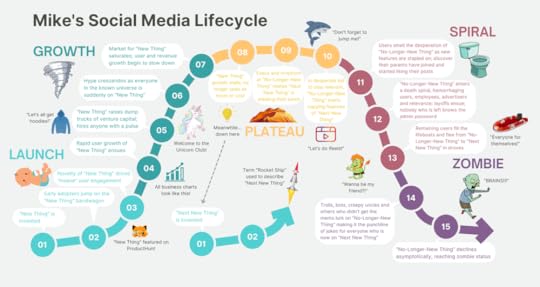
Though the slope, duration, and arc of this lifecycle may vary, it is as immutable as the laws of physics. My parlor game whenever somebody disputes this premise in casual conversation is to ask them to name a social media platform (or really any consumer internet service) that, once it peaked and lost its cool factor, reinvented itself and regained its momentum. I have yet to hear anyone even offer a reply, let alone a compelling response. Just like 80s hair metal bands, Frasier reruns, and Dennis Rodman, social media platforms don’t age well. Once they jump the proverbial shark, nothing can bring them back—though nothing can kill them either.
I’m not saying Facebook, Instagram, and Twitter have become zombies just yet. They still have billions of users and may yet extend their useful life. On the lifecycle chart, I’d put Instagram at Stage 8, Facebook at Stage 10, and Twitter tipping into the downward spiral of Stage 11 with Elon Musk shoveling stacks of money into the furnace to achieve failure even faster. But all of them will get to zombie status eventually, joining a long list of social networks before them. TikTok will end up there too before long.
This dynamic is perhaps the most confounding reason it is so difficult to regulate consumer internet companies. By the time regulators wake up to the monopolistic threat of the current dominant market leader, and the slow wheels of democracy endeavor to do something about it, some new upstart is already kicking the incumbent’s ass. It’s like tying an anchor to a sinking dinghy—you’re just hastening its demise.
The difference between social media platforms and other hits-driven businesses is that at that peak of the hill, multi-billionaires are created. Sure a hit song or TV show or video game can make its creators a lot of money, but not social media sized money. The smart founders get off the ride before the inevitable plunge. Time will tell who the smart ones will be. In the meantime, I need to create a TikTok account—an act that will guarantee it will soon become uncool.
September 30, 2022
The Power of Live Events
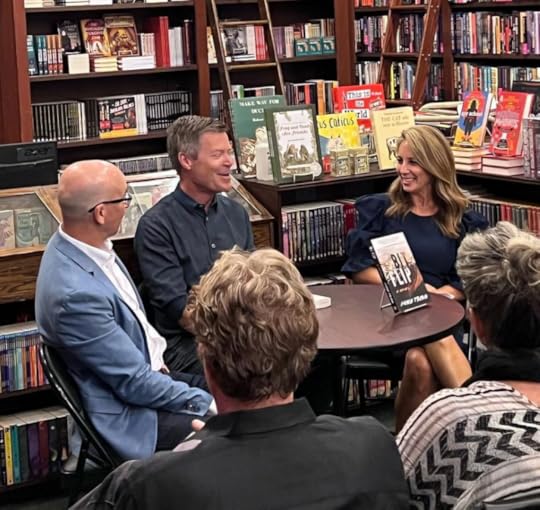
Discussing BIT FLIP with WABC-TV’s Lauren Glassberg and TechRadar’s editor-in-chief Lance Ulanoff at The Mysterious Bookshop in Tribeca.
One of the aspects of my book launch that I was most looking forward to has been the return of live events. I feel incredibly fortunate that I didn’t have my book tour canceled by COVID or relegated to Zoom, as so many authors did during the last two years.
There is something undeniably energizing about an in-person event that, in my opinion, is impossible to capture online. As my book tour kicked off, I was quick to fully recognize that the opportunity to discuss my book and the topics it raises with a real, live, in-person audience would be the most gratifying part of this entire experience.
That is why I wrote this book. It wasn’t to make money (or even a living!). It wasn’t to be a bestseller (even though that would be kinda nice!). It wasn’t to have Bit Flip made into a film or TV show (though that would be cool!). The reason I wrote Bit Flip was to stimulate conversation. I describe the book as a cultural critique disguised as a corporate thriller. It’s the critique that’s the fun part to discuss with readers. That’s what matters to me: impacting the national dialog about tech and the tech industry’s influence on our lives.

Speaking with Mehran Sahami at Book Passage in San Francisco.
So far, I’ve already hosted nine live events, including Palo Alto, San Francisco (twice!), Marin, Sonoma, Walnut Creek, Columbus, New York, and Seattle. Thanks to my trusty iPhone and an inconspicuous 6-inch tripod, I’ve been able to capture most of these events in their entirety, which you can find links to view on my site or on my YouTube channel. And I still have seven events coming up in Chicago, Wisconsin, Colorado, and four in Palo Alto!
In addition to the joy of hosting these live events in the first place, I’ve been incredibly fortunate to collaborate with some of the best thinkers in the world about this topic. I can’t do justice to the amazing bios of my conversational partners here, but I’ll do my best:
Mehran Sahami and I worked together twenty years ago at E.piphany. He is the James and Ellenor Chesebrough Professor in the School of Engineering, and Professor (Teaching) and Associate Chair for Education in the Computer Science department at Stanford University. He is also a Bass Fellow in Undergraduate Education. Prior to joining the Stanford faculty, he was a Senior Research Scientist at Google. Mehran co-authored an outstanding book on how we can mitigate the negative aspects of the tech industry called System Error: Where Big Tech Went Wrong and How We Can Reboot.
Margaret O’Mara and I first met at Northwestern University where we were both history majors. She is the Scott and Dorothy Bullitt Chair of American History and Professor at the University of Washington. Margaret writes and teaches about the growth of the high-tech economy and its intersection with American politics. Her work has appeared in The New York Times, The Washington Post, WIRED, and other publications, and she has authored two acclaimed books on the history the tech industry: The Code: Silicon Valley and the Remaking of America and Cities of Knowledge: Cold War Science and the Search For The Next Silicon Valley.
Parker MacDonell happens to have grown up in Lima, Ohio, the same home town as my protagonist, Sam Hughes. A seasoned financial services and business executive who serves as an Advisory Partner at Rev1 Ventures in Columbus, Parker is a long-time tech investor and leads the Ohio TechAngel Funds, a group of for-profit investor funds that invest in high-growth, high-tech companies in Ohio, focused on the IT, advanced materials, and life sciences sectors.
Laila Tarraf and I got our MBAs together at the Haas School of Business at the University of California, Berkeley. Laila has been a senior People executive at several Bay Area companies, including AllBirds, Peet’s Coffee and Tea, and Walmart.com. She also wrote a heart-wrenching memoir called Strong Like Water: How I Found the Courage to Lead with Love in Business and in Life in which she shares her professional journey after losing her husband, father, and mother in quick succession.
Lance Ulanoff, who joined me for an interview with my long-time friend and WABC-TV Emmy-award winning journalist Lauren Glassberg, is Editor-in-Chief of TechRadar. Lance has covered the tech industry for over thirty years, previously as Editor-in-Chief of Lifewire, Chief Correspondent for Mashable, Editor-in-Chief of PCMag.com, and SVP of Content at Ziff Davis. He also makes frequent appearances as the tech expert on TV news programs, including Live with Kelly and Ryan, Fox News, Fox Business, the Today Show, Good Morning America, CNBC, CNN, and the BBC.
These incredible collaborators have been so generous with their time and brought so much to the conversation. I just can’t thank them enough.
Thanks also go out to the awesome book stores who have hosted me for these events. The commitment and passion that these stores show to their communities by taking the time to organize and promote events such as these leave me in awe. Huge thanks to the owners, managers, and staff for all their hard work.
Finally, and most of all, thank you to everyone who has made it out to a live event. Without an audience, it isn’t an event. The engagement, intellectual curiosity, and enthusiasm of everyone who has joined us has been overwhelming. I can’t thank you enough for your support.
So, if you’re able to join one of my upcoming events, I look forward to seeing you there. If you can’t, I encourage you to watch one of the replays which I’ll continue to post on my site. Thank you all.
September 28, 2022
The Real Publishing Industry

Photo by Gülfer ERGİN on Unsplash
One of the favorite topics of discussion for people in the publishing industry is. . . the demise of the publishing industry. From the rise of the evil empire of Amazon, to the proliferation of self-published books, to the relentless consolidation of publishing houses, signs abound that the publishing industry is “not what it used to be.”
Industry statistics support the anecdotal evidence. After peaking in 2007, U.S. bookstore sales have declined 42%. The traditional book publishing industry overall in the U.S. contracted 17% over the last decade—from $32.4B in 2011 to $26.8B last year, declining 3% per year on average. That’s not a healthy industry.
A recent Twitter storm precipitated by a post by the author April Henry shows just how bad things have become in the traditional book publishing industry. Henry cited statistics disclosed in the Penguin Random House/Simon & Schuster antitrust trial, claiming that of the 58,000 trade titles published per year (these are the “best” books by the “big five” publishers), half sell fewer than one dozen copies and 90 percent sell fewer than 2,000 copies. Although other authors and publishing experts have disputed these numbers, with one asserting that, never fear, it’s only about 15% of trade-published books that sell fewer than a dozen copies and that 7% sell more than 10,000 copies (phew!), the data is undeniably depressing. The New York Times reported that 98 percent of published books released in 2020 sold fewer than 5,000 copies.
And these data are for the ostensibly best and biggest publishers. It doesn’t even include the sales of self-published books, which have exploded in recent years. None of this should come as a surprise. Like any market, the book industry is governed by the laws of supply and demand. As the traditional publishing industry has struggled due to low demand from readers, a vibrant new opportunity has flourished thanks to the supply of authors. That leads me to the core thesis of this post:
The real publishing industry today is not selling books to readers, it’s selling services to authors.
Obviously, the exponential growth of self-publishing has fueled this parallel new author-focused publishing industry. According to ProQuest Bowker Report, nearly 1.7 million books were self-published in the U.S. in 2018, up 264% in 5 years. By 2019, the total number of books published in the U.S., both traditional and self-published, exceeded 4 million. That’s incredible growth, and a lot of authors looking to hire help to publish and promote their books. The entrepreneur in me says, “Market Opportunity!”
The interesting question is whether this new author-driven publishing industry is already bigger than the gradually declining traditional reader-driven publishing industry. Although reliable statistics are hard to find, my firm belief is that yes—yes, it is.
The reason I believe this is that publishing a book is not inexpensive. As I can attest.
Although I worked with a great independent publisher, I still shouldered most of the the costs of publishing and promoting my book myself—including hiring editors, designers, and publicists. Even traditional big five publishers have had to scale back the support they offer authors, since it only makes it harder to be profitable. It’s a matter of simple math. For the 98% of traditionally published books that sell fewer than 5,000 copies, the publisher only stands to make $20-30K . . . best case. That implies a very small budget to edit, produce, distribute, publicize, and promote a book and remain profitable. So publishers are naturally reducing their advances, minimizing their investment, and pushing more of the financial risk to authors.
There’s a favorite joke among winemakers: How do you make a small fortune in the wine business? Start with a large fortune. The same seems to be increasingly apropos of writing books. Although each author’s personal investment in their book will vary, the vast majority of those 4 million authors will lose money on their book
As an author, there is a never-ending smorgasbord of vendors offering to help your book become the next bestseller. From ghost writers to copyeditors, proofreaders to publicists, nearly every resource you could possibly need is available for hire. Entire marketplaces like Reedsy make it easy to find and hire talent. And once the book is finished, there are even more ways to spend money promoting it. Need book reviews? You can buy those. Want an award? Pay to submit your work. Need media coverage? Hire a publicist. Want sales? Buy ads on Amazon or Goodreads or "Boost" your posts on Facebook. Since my book launch, an entire cottage industry of service providers have come out of the woodwork offering to promote my book in everything from paid reviews to Bookstagram “influencer” campaigns.
While authors can spend a nearly limitless amount to publish and promote their work, the challenge they face is the same one crushing the traditional publishing industry: the more you invest, the more you need to sell to break even.
Let’s take the case of a truly self-published work, usually via Amazon where the author makes 60% of the sale of their book, and assuming a generous average sales price of $16 (most self-published titles sell for well below that amount). The typical self-published book costs the author about $2,000, but the investment by an author can vary—from a low of around $1,000 to a high of $20,000 and up. Here are some hypothetical investment levels, depending on the budget of the author, and what is required in terms of book sales to break even:
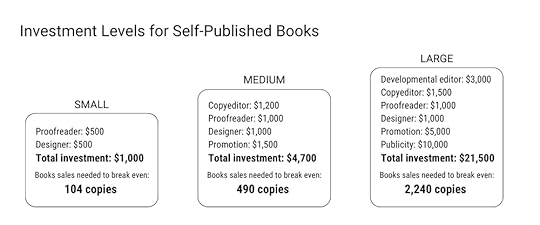
The challenge is that it’s extremely unlikely at any of these investment levels, that the sales of the book to readers will surpass the money spent by the author on service providers. That means the vast majority of authors will spend more to publish and promote their book than they will make from selling their book. Which is why I conclude that the industry of selling services to authors is already bigger than the “traditional publishing industry” of selling books to readers.
Even with the advantages of an award-winning independent publisher that I love (SparkPress) with high editorial standards, expert resources, and traditional distribution to bookstores across the country, I will be hard pressed to break even on my personal investment in publishing Bit Flip. Seeing these statistics on book sales by big five publishers makes me feel much better about my sales figures to-date, which already have me in the top quartile of book sales after only one month! With the average U.S. book now selling fewer than 1,000 copies over its lifetime, I'm hustling to be the book that breaks out.
I’m fortunate enough that I don’t need to make a living from my writing (not even sure that’s possible anymore). Further, I can rationalize my investment as building for the long-term, since I have already written my second book and plan to publish multiple books. But the reality is increasingly undeniable—as production exceeds consumption, the growth market is on the supply side.
August 31, 2022
The Importance of Lima
This week, I had the privilege of visiting Lima, Ohio—a town of 35,000 people located about 90 miles northwest of Columbus, and the hometown of Sam Hughes, the protagonist in my novel, Bit Flip.
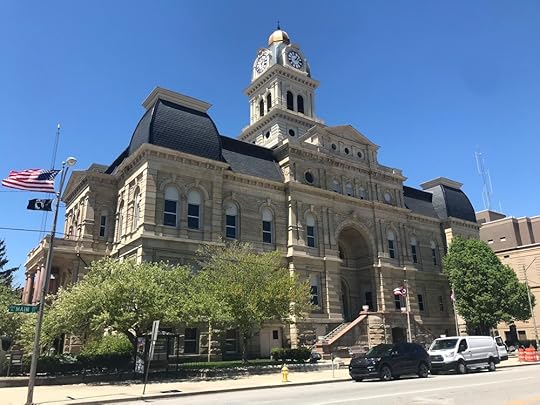
The Allen County Courthouse in downtown Lima, OH.
I had not visited Lima prior to writing it into my story, but I researched the town quite extensively. I read about its history, looked at pictures, and virtually walked the streets using Google Street View. I learned about its economic booms and busts, demographic trends, and brief notoriety as the setting for the Fox television series Glee. I discovered that the school Glee is based on, William McKinley High School, doesn’t even exist, but Lima Senior High School does, and locals call it simply “Lima Senior,” and their mascot is the Spartans. I learned the town was founded in 1831, serves as the county seat for Allen County, and is properly pronounced LY-mə, not LEE-mə, the capitol city of Peru, after which the town is named.
After all that research, I chose Lima because I saw it as representative of the challenges many Midwestern towns have gone through over the last several decades. It’s a history that is all-too familiar. One that could be told by many other Rust Belt towns.

A map of Northwest Ohio Reservations in the early 1800s (https://www.shawnee-nsn.gov/history)
Of course, that history starts well before the founding of Lima in 1831. The Shawnee Tribe had lived in northwestern Ohio for centuries. But the land was taken, as it was taken from so many other native populations, to create white settlements in the Midwest—first by treaty in 1817, then through the creation of the Hog Creek Reservation, and ultimately by the Federal Government’s Indian Removal Act of 1830 which resulted in the complete surrender of all their remaining land and forced relocation to Kansas.
The subdividing of that land by “settlers” created the agricultural grid that still surrounds Lima today, and farming drove economic expansion and population growth through the latter half of the 1800s. The value of that land increased dramatically in 1885 with the discovery of massive oil fields near Lima. By the turn of the century, the area was producing over 20 million barrels of oil annually, making it the leading oil producing region in the entire nation. Consequently, Lima’s population surged in the early part of the 20th century, nearly tripling from 1890 to 1920 to a bustling town of over 40,000 residents.
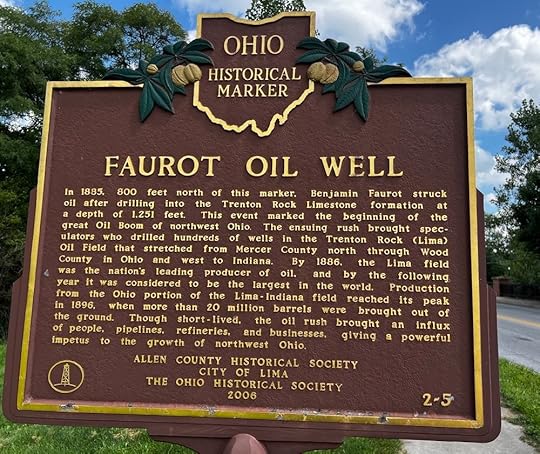
Historical marker for the site where oil was discovered in 1885.
A second engine of economic growth was the railroad industry. Lima served as a critical hub for multiple railroad lines and was the home of the Lima Locomotive Works that produced steam locomotives. From that industrial base, other manufacturing businesses sprouted up. The Gramm-Bernstein Motor Truck Company produced their acclaimed Liberty Truck during World War I. United Motors Services produced tanks for the military beginning in World War II. And the Superior Coach Corporation produced everything from fire trucks to ambulances.
The economic prosperity turned Lima into a cultural center as well, with grand hotels, ornate mansions, an esteemed symphony, and a stately opera house. Despite the economic setbacks of the Great Depression and the post-war downturn in military spending, Lima continued to prosper through the 1950s and 60s, reaching a peak population of 54,734 in 1970.
Perhaps ironically, the industry that built Lima also triggered its demise. In 1969, a massive oil spill forced the evacuation of thousands of residents. Racial unrest erupted in the highly segregated city in 1970 after a black woman was killed by police. A string of plant closings took place over the following decades, costing the area thousands of jobs, depicted in the 1999 PBS documentary “Lost In Middle America and What Happened Next” that profiled the efforts to save the British Petroleum oil refinery which was slated for closure in 1997.
Although the plant was eventually saved, the economic decimation of Lima continued, with one report estimating Lima lost 23 percent of its jobs between 2000 and 2003, followed shortly thereafter by the 2008 financial crisis. With the massive loss of jobs and businesses, Lima’s population steadily declined, reaching just 35,579 in the 2020 census—a contraction of 34 percent from its peak.
As San Francisco is discovering, it is difficult to grow your economy when your population is shrinking. Today, Lima’s unemployment rate is 4.3 percent, well above the national average, while wages in many industries have declined. Median income in Lima is $34,586, far below the national median income of $67,521. The net effect is the poverty rate in Lima is an astonishing 24 percent, more than twice the national rate of 11.4 percent.
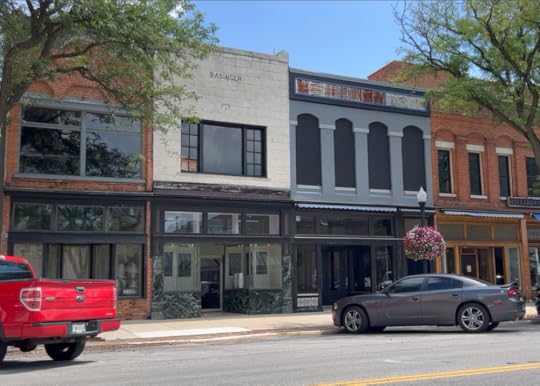
Vacant storefronts on Main Street in Lima, Ohio.
The evidence of these economic hardships is readily apparent when you visit Lima. Entire blocks of storefronts on Main Street are vacant. Many commercial buildings in the center of town have long been abandoned. The suburban sprawl of strip malls and big box stores that hastened the decline of Lima’s downtown is faring no better, much of it now empty parking lots overgrown with weeds. The only businesses that seem to be doing well are hospitals, fast food restaurants, and retailers who target underprivileged areas.
It’s hard to know what to do to help a city like Lima. It’s hard to even acknowledge the problem. Although new manufacturing jobs have been created elsewhere in the state, these projects often come with steep tax breaks and taxpayer investment—only to create a new economic dependence. Investment by businesses can feel like extortion. Empathy from outsiders can feel like pity. Compassion can feel like condescension. Most remaining residents just want their jobs back, to regain the sense of pride and livelihood for what the city once was. But many others have accepted the fate, and left Lima to pursue economic opportunity elsewhere—as Sam does in the book.
The answer to what to do about the fate of a city like Lima often comes down to financial means, creating a dynamic that can hollow out of a community. A division between “haves” and “have-nots,” where the haves leave, and the have nots stay—fostering guilt and resentment on both sides. The undeniable reality when one visits a town like Lima is that the economic prosperity of the last two-plus decades have not been shared equally. If you’ve lived in California or New York or other prosperous areas during that time, you’ve been living in a bubble. Your income has been rising, while incomes in less fortunate regions have been declining. If you can’t understand the populist movement that has upended American politics, visit Lima. As they say, “It’s the economy, stupid.” The first step to rectifying that economic inequity is understanding it.
I’m glad I picked Lima. Although I worry my depiction of it is insufficient, I believe it captures what I wanted to represent—a town that is understandably pissed off but where there are no right, or easy, answers.
August 30, 2022
Virtual Book Tour
This image of the San Francisco skyline that appears on the front cover of Bit Flip was taken by Kehn Hermano and discovered on Pexels.com by my cover designer, David Provolo. I thought it perfectly captured the beauty of the city, with just a hint of an ominous vibe thanks to the long shadows. The U-turn in the road also perfectly symbolizes the “change of heart” that is encapsulated in the book’s title—a “bit flip” is when a bit changes from 0 to 1 or back, and is a metaphor for changing one’s mind 180 degrees.

Photo by KEHN HERMANO: https://www.pexels.com/photo/an-aeria...
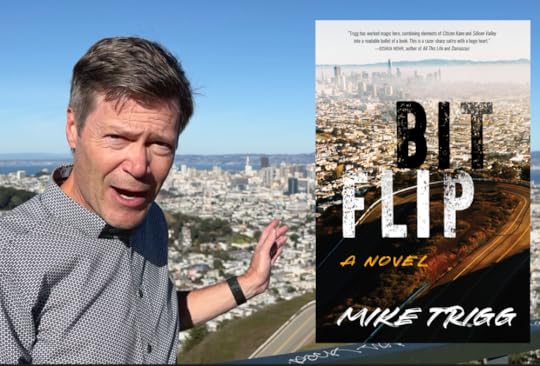
Once we decided on that image for the book cover, I immediately became curious, “Where is that?” I knew it was near Twin Peaks, the highest point in the city. But I eventually found the exact spot: Christmas Tree Point overlooking Twin Peaks Drive. I was compelled to visit that location myself, and that’s when inspiration struck: “What if I did a virtual tour of the real-world locations that are featured in the book?”
The product of that idea is what I call the Bit Flip Virtual Book Tour.
I’m now 7 episodes into the tour with 20 total episodes planned. I release a new episode on YouTube every Tuesday, and you can subscribe to my YouTube Channel to be notified when new episodes are available. This series has been a fantastic way to bring the book to life. Each episode is time-consuming to produce, but the response has been incredible—with over 5,000 combined views so far across the series.
They have also been a blast to create! Armed with just my iPhone, a tripod, and a $137 Shure microphone I bought on Amazon, I have shot these videos all over the San Francisco Bay Area. And I just shot an episode in Lima, Ohio, the hometown of my protagonist, Sam Hughes, which will come out next week.
Here’s a summary of the series so far, with links to each episode:
Introduction—Kicking off the series from The Stanford Dish overlooking Silicon Valley.
Twin Peak—The first stop on the tour: the view on the cover from Christmas Tree Point.
The Embarcadero & Moscone Center—This picturesque boulevard appears in Chapter 1, when Sam is summoned to a conference at Moscone.
Richardson Court—Visiting the block in Palo Alto where Sam lives with his family that first appears in Chapter 3.
Four Seasons Silicon Valley—The location of the “avocado scene” where Sam has breakfast with one of their venture investors.
Golden Gate Bridge & Cavallo Point—Sam attends an executive off-site at Cavallo Point Lodge under the Golden Gate Bridge in Chapter 4.
SoMa—Sam spends a day in Chapter 8 interviewing for jobs in SoMa, the heart of the tech district of San Francisco.
I hope you enjoy these and the episodes to come. Don’t forget to share, like, and subscribe!
August 16, 2022
Writing Impaired
Today, my book, Bit Flip, finally launches into the world! As I celebrate this milestone and my publicity campaign around the book really kicks into high gear, I’m gradually coming to grips with a physical challenge I didn’t realize I have.
I’m not a very good writer.
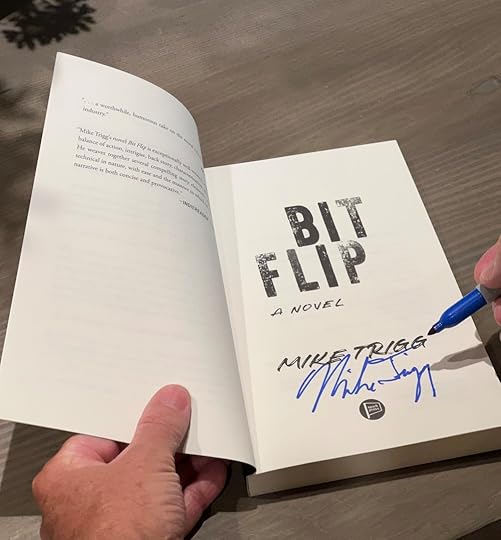
Maybe my best signature yet!
I don’t mean writing blog posts and novels and stuff—those things I’m passably competent at. I mean actual handwriting. With a pen.
This impairment is one that I have apparently been living with for some time without even knowing. The extent of my handwriting challenge was revealed to me recently as I’ve started sending hand-written thank you cards, writing cover notes, and signing copies of my book. On many occasions, I’ve been horrified to notice my handwriting appears to be stuck at a 3rd-grade level. It’s so bad, I’m starting to question if I’m really right-handed. Perhaps it would look better if I wrote with my left hand. Or my toes.
Like a lot of professionals, especially in tech, almost all of my writing is done on a keyboard. Handwriting is a disappearing art form. Most children today skip right past handwriting, learning only texting. The last thing I hand wrote was a Post-it Note. I used to occasionally take notes by hand, but I haven’t really done that since circa 2004 when Evernote came along. I’m just much more efficient in QWERTY or my thumbs than in ink. I can type about 2,000 words a minute. Faster than my brain can keep up. Consequently, my handwriting has atrophied. My pace for handwriting is about one word per half hour. It requires near-total concentration not to miss a letter, or forget how to even form the letter in the first place.

A cheat sheet I keep with me at all times. (Photo by Poppy Thomas Hill on Pexels)
In addition to the slow pace, my writing style is stunted as well. My grade school writing teacher might be proud of the proper cursive I’ve retained into my adulthood. Far from the illegible scrawl of a doctor or a lawyer, my handwriting is a continuous script of loops, curves, and ornamental flourishes. Unfortunately, those characteristics also make it look like a child’s diary from the 1980s. It only gets worse when I write in colored ink, or use lined paper, or add smiley faces to dot my i’s.

Copies of my book I managed to successfully sign at Kepler’s in Menlo Park.
I could keep my handwriting shame a secret if it weren’t for these damn book launch events. I had the privilege of signing a stack of my books at my local bookstore, Kepler’s, today. Each signature appeared to be written by an entirely different person. My hand started cramping after signing approximately three. I’ve researched signature stamps on Amazon but that seems like cheating. My greatest fear is that a reader will ask me for more than just my signature, like a personalized note or tribute. It might mean I only manage to sign one book during an hour-long book event.
To remedy this situation, I bought a box of Sharpies yesterday and have started to practice. My recycling bin is filling up with what look like the scribblings of the Unabomber. ATF may soon be raiding my house. But with a full calendar of events this fall, I’m hopeful I can at least learn to mimic the effortless penmanship of a professional author. Wish me luck!
August 1, 2022
Launch Month!

Photo by SpaceX on Unsplash
It is time. For over a year, I have been eagerly awaiting the launch of my book, Bit Flip, and now it is finally available on August 16. This milestone has felt like a mirage for some time—something so distant that it seemed like it may never happen. Now, with the book on the cusp of being reality, I’m anticipating the inevitability of it like I’m at the peak of a roller coaster. All the hard work of making that climb is about to pay off! Suddenly, there’s a lot going on, so I thought I’d summarize all the activity here.
SPEAKING EventsWriting, editing, and publishing a novel is a mostly solitary endeavor. But I’m a social person. So, particularly after two years of the pandemic, I am very much looking forward to real, live, in-person events, starting this month and continuing through the fall, to discuss the book with other human beings. I’m thrilled to have so much support, particularly from Bay Area bookstores that I have enjoyed for years as a reader.
My calendar currently has me speaking at 10 book events around the country between now and October, from book signings to panel discussions. To keep track of it all, I have created a new Events page on my website, where you can see all my upcoming speaking appearances in one place.
The Bit Flip World Tour starts with an in-store event at my local Books Inc in Palo Alto on Thursday, October 18 at 6:00pm. I will then speak at Book Passage’s store in the iconic Ferry Building (a location that makes a cameo in the book) on Sunday, October 21 at 2:00pm. I will be joined in conversation at both events by my colleague, Mehran Sahami, co-author of the excellent book System Error: Where Big Tech Went Wrong and How We Can Reboot. From there, I will visit Columbus, Sonoma, Marin, Seattle, New York, and cap it all off with a talk at the Fox Cities Book Festival in my hometown of Appleton, Wisconsin. Can’t wait!
Virtual Book TourFor those of you who can’t join a live event, I am doing a series of short videos in which I visit many of the real-world locations in the San Francisco Bay Area that make appearances in the novel. The first three episodes are available now both on a new Videos page on my website and on my YouTube channel.
I will be releasing new episodes, typically only 1-2 minutes long, every Tuesday through the fall. Whether you’re a local or have never been to the Bay Area, these videos are a fun way of bringing the story to life by visiting many of the hotels, restaurants, and scenic locations used as settings for scenes in the book. I encourage you to subscribe to my YouTube channel for the latest and share these videos on your social media with the hashtag #BitFlip.
Media CoverageI’ve been busy providing interviews with over twenty media outlets the last several months. Much of that coverage has been scheduled for August to coincide with the release of the book. I will be posting coverage to my website on another new page titled Media, and sharing it on my social channels as it appears.
Some of the coverage has already started, including my interview with Foreword Reviews following on their 5-star review of Bit Flip in March, my interview with Authority Magazine on the “5 Things You Need to Be a Successful Author,” and my radio interview on KZSU’s “Interesting Beings” show.
To stay up-to-date with the latest, be sure to subscribe to my newsletter if you haven’t already. Thanks again for all your incredible encouragement and support!
July 23, 2022
Fake It Till You’re Fraudulent

Photo by Tima Miroshnichenko
With the recent verdict against Sunny Balwani, the former Theranos COO accused of widespread fraud, the second shoe has finally dropped in perhaps the most notorious fraud case ever for a Silicon Valley venture-backed tech company. Like Elizabeth Holmes, his more infamous business and romantic partner, Balwani was found guilty of multiple counts of fraud.
While the Theranos scandal may have been an outlier, the conclusion of the case serves as a timely reminder that it is time to reel back one of Silicon Valley’s most deeply held beliefs: exaggerating our own hype.
The glorious retrospective back stories of successful Silicon Valley tech companies are rife with tales of hype far exceeding reality. From Apple to Amazon, entrepreneurs are taught the same lesson: if you want to make it big, you need outsized hype. You need spin to win. Building a company and gaining investors requires falling in love. Rarely does the pitch, in its stark, underwhelming near-term reality, smite potential investors, customers, and employees as much as the grand future vision does.
This tendency is encapsulated in terms frequently heard from incubators to cocktail parties in Silicon Valley. Entrepreneurs will admit to “vanity metrics”—statistics about their businesses that sound impressive but are often meaningless. Designed to convey an impressive level of “traction.” Young founders are encouraged to “fake it till you make it,” essentially to pretend they and their business are much more impressive than they really are with the hope they will “grow into the story” over time.
Almost every founder weaves an outsized tale of their company’s momentum and potential. As a multi-time founder and senior marketing executive at various tech start-ups, I’ve certainly been the one responsible for generating that hype at many points in my career. Belief—even when there are few facts to support it, even when all the evidence is to the contrary—is essential to the success of any start-up company. If you allow yourself to be overly burdened by what is, you’ll drown. You need to focus on what will be, and the path for getting there—not only for investors, customers, and employees, but for yourself. The decision to found or join a start-up is, in most cases, an irrational one, fraught with risk. The hype helps you muster the enthusiasm to overcome those insurmountable odds.
Venture investors, for their part, also deserve their share of blame for Silicon Valley’s hype hyperinflation. Despite their reputation as clear-headed financiers, VCs can be surprisingly prone to believing their own hype. One prominent Silicon Valley VC once privately admitted to me he decides on an investment in the first 5 minutes of a pitch, then everything else is seeking affirmation to justify that impulse decision. Once the investment is made, VCs have even more incentive to grab on to any proof point, anecdote, or vanity metric they can in an effort to hype up the company to other investors, tech media, recruited executives, their own partners, and everyone else in the ecosystem who needs to be fed a story. Venture investors arguably have a pronounced conflict of interest when it comes to their fiduciary responsibilities. As board members, they ostensibly provide oversight, but, in reality, they need new downstream investors, acquirers, or the public markets to believe the hype in order for their investment to appreciate and achieve an exit.
When founders and investors align in a self-perpetuating, white-hot hype echo chamber, the results can be disastrous. This proclivity for exaggeration over transparency, spin over substance, hype over diligence creates a slippery slope that can tip into outright lies and even fraud. The reality never catches up. My upcoming novel, Bit Flip, dramatizes just such a scenario. What starts out as liberal revenue recognition, escalates into falsified accounts, and, ultimately, outright fraud within the protagonist’s start-up company—putting him in a moral dilemma about what to do about it. Although fiction, the situations, incentives, and escalations of the story are all too real.
When this situation happens in real companies, it usually breaks one of three ways:
Scenario 1: By far the least likely outcome, but the one we all love sharing examples of, is the company actually does live up to the hype. We love this outcome. The one-in-a-million exception that rationalizes the practice. The extreme outliers that all others try to emulate. The “aw shucks” and “remember when” stories that get told in memoirs and biographies. Yours is most likely not this company.
Scenario 2: For the vast number of start-ups in the middle of the bell curve, at some point, the hype bubble bursts. Investors actually ask the tough questions, dig into the details, look under the hood. They realize that they need answers to the questions they’ve been afraid to ask. That spin and hype have become self-delusional. This is the “come to Jesus” moment for many start-ups, when they simply can’t take another sip of their warm, saccharine Kool-Aid. Down rounds, founder swaps, and employee layoffs are a best-case scenario. Some of these companies manage to get their act together and traverse the painful path back to reality. But the vast majority are too far gone. They’re end-stage.
Scenario 3: At the other extreme of the spectrum lie the equally fascinating implosions. The companies that reach a point where the hype has become so outsized, so metastasized, for so long, and so completely detached from reality that they are poised for catastrophe. The Theranoses of the world. The companies who “faked it” till they were fraudulent. Though convicting founders of criminal fraud, as in the Theranos case, is rare (recent charges brought against the CEO of electric truck maker, Nikola Corp notwithstanding), incidents of self-dealing, dysfunctional work environments, and unethical business practices abound—see WeWork, Zenefits, Uber, and many others. High-flying media darlings that plunge to earth so spectacularly that we can’t look away.
With the days of free-flowing venture capital waning, we may see a commensurate balancing of hype with reality. As we’ve seen in past economic cycles, corporate fraud which can proliferate in boom markets often gets exposed when the financial tide recedes. The ensuing fiscal conservatism can temper the grow-at-all-costs mindset. As more tech companies are forced to hunker down for the first time in over a decade, it’s a moment to recalibrate and make sure their reality really can keep pace with their hype.



